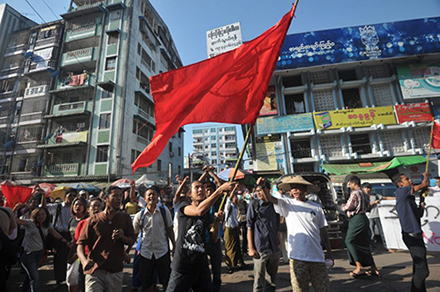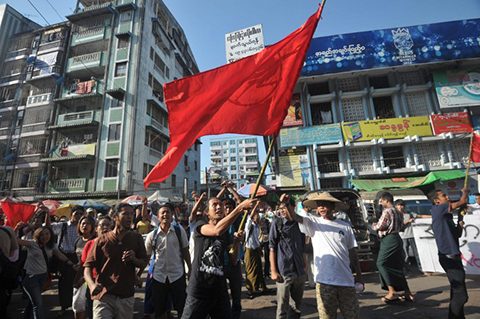
Myanmar student protesters and nationalists shout slogans and wave flags during a demonstration supporting the student protests . Photo by AFP.
Recent news reports are telling the world that protests and repression of protesters persist in Myanmar. To some people, this looks as if Myanmar’s reforms are failing, or are doomed; it looks as if Myanmar’s political “transition” has not resulted in as much change as some observers claimed, and is not really going anywhere; it foreshadows the reversal of various liberalisations introduced during 2011–13 and the possible end of Myanmar’s “democratisation” such as it is; it also seems to bode badly for Myanmar first post-military regime general election at the end of 2015.
These latest developments raise more questions than answers.
What is the current political situation in Myanmar? How should the repressive actions of Myanmar’s law enforcement authorities, especially over the past two years, be interpreted? What sorts of response are most effective, either internally or externally, to protect against such repression? Will these acts of official repression really spell the end of Myanmar’s reforms? Can anything be done to reverse this downward trend and/or to consolidate reform processes already in place? Can Myanmar’s leaders re-position their political agenda to ensure that opportunities for further progress and improvement are not lost? And at a time when reforms and similar positive outcomes are fading or being overturned in so many other parts of the world, what is reasonable in terms of expectations or realistic hopes in the case of Myanmar?
During 2011–12, the current Myanmar government introduced a variety of political reforms such as freedom of association and freedom of expression, ended press censorship, permitted public demonstrations and protests, allowed trade unions, and tolerated opposition to illegal land grabs. Popular reactions were positive, quick and clear: ordinary Myanmar people frequently took to the streets to protest publicly; Myanmar newspapers regularly reported issues from the point of view of complainants, not necessarily objectively; public feelings often ran high, and violence was sometimes the result.
Not entirely surprisingly, Myanmar’s political system struggled to manage the extent of open dissent and disagreement that ensued. Political leaders and parties issued well-meaning statements, but found they sometimes had little impact on the real issues; Myanmar government agencies sometimes reacted harshly and in a heavy-handed way, often making matters worse; and members of the new Myanmar parliament sometimes seemed out of touch and unable to offer timely or lasting solutions. Resolution of serious ongoing conflict – such as the continuing insurgency in Kachin State in the north, the mistreatment of the Muslim Rohingya minority in the west, and the occasional eruption of inter-communal sectarian violence – sometimes seemed further away than ever, with few practical mechanisms available to resolve immediate differences or to overcome more deep-seated frictions. In general terms, the habits of collective restraint and purposeful collaboration employed in other situations seemed insufficient in the face of apparent systemic disintegration in Myanmar.
Specifically, the Myanmar Government’s peace negotiations process – under way since 2012 – seemed incapable of producing a final single settlement to which all parties could agree. Moreover, evidence of human rights abuses by the Myanmar army in insurgency areas and elsewhere continued to emerge. Some Myanmar leaders questioned whether the Myanmar Government was really committed to continuing reform, especially when some journalists were arrested in apparent crack-downs on freedom of expression and when breaches of land rights seemed to go unpunished. Trust was being eroded rather than restored.
In reality, the overall trajectory of reform in Myanmar continues, although some specific political reforms may have been implemented rather in the letter than in the spirit. Political leaders rightly worried about the potential impacts for the conduct of the general elections expected in late 2015, but still without a specific date or detailed procedures being announced. The situation was not helped by the Myanmar Government’s refusal to proceed with substantive constitutional change before the elections, or by their ongoing reluctance to allow opposition leader Daw Aung San Suu Kyi to be a candidate for the presidency.
International media reporting about Myanmar tends to focus on negative developments, influenced partly by activist campaigns, and by emerging evidence of over-reach by the Myanmar authorities. (This reporting did not always cover contributing causes, including protesters seeking to push law enforcement authorities as far as possible, or long-term historical tensions re-surfacing.) Frustrated domestic protesters sometimes seem to adopt tactics designed to force the Myanmar authorities to change, even though this might involve risks for protesters.
While communication between opposing political groups in Myanmar might not be promising, it has not broken down completely as has occurred in some other countries. Even as Myanmar police were criticised this month for cracking down on protesters, for example, Aung San Suu Kyi had meetings with Myanmar Government leaders. But, clearly, more effective action is urgently needed to lock in rule of law improvements that are essential for under-pinning sustainable nation-wide reforms and for reducing symptoms of ongoing abuse.
Trevor Wilson is a Visiting Fellow, in the Department of Political and Social Change at the ANU Coral Bell School of Asia Pacific Affairs. The ANU College of Asia and the Pacific’s 2015 Myanmar Update, running 5-6 June, will look at the topic “Making sense of conflict”.
 Facebook
Facebook  Twitter
Twitter  Soundcloud
Soundcloud  Youtube
Youtube  Rss
Rss 